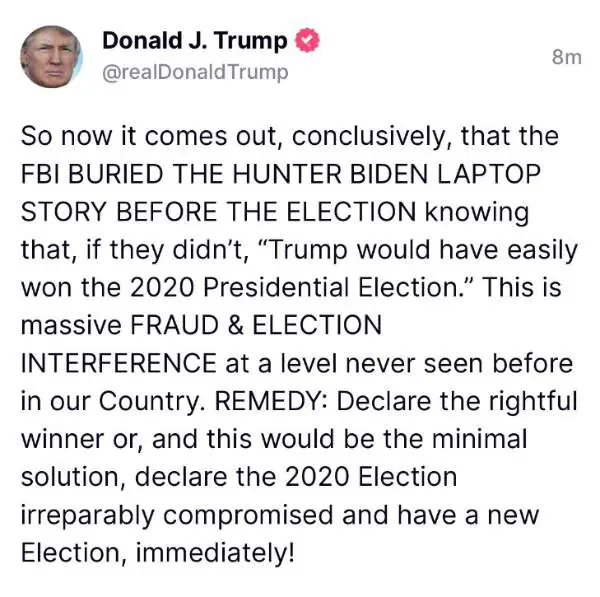As former United States President Donald Trump continued making false and increasingly shrill accusations in August 2022 that he had only lost the 2020 election because it was “rigged” against him, it marked nearly a decade since he began pushing that type of disinformation for his own benefit.
In November 2012 Trump reacted to then-U.S. President Barack Obama’s re-election win by complaining (falsely) that Obama had “lost the popular vote by a lot and won the election.”
“We should have a revolution in this country!” he added, foreshadowing his purported attempt to instigate a coup attempt against the United States Capitol in January 2021 to prevent lawmakers from certifying his loss of the presidency.
At the time of Obama’s re-election, conspiracy theories surrounding his defeat of former Massachusetts Gov. Mitt Romney were collected into a meme. The claims included:
- “In 59 voting districts in the Philadelphia region, Obama received 100 percent of the votes with not even a single vote recorded for Romney. (A mathematical and statistical impossibility).”
- “In 21 districts in Wood County Ohio, Obama received 100% of the votes where GOP inspectors were illegally removed from their polling locations – and not one single vote was recorded for Romney. (Another statistical impossibility).”
- “In Wood County Ohio, 106,258 voted in a county with only 98,213 eligible voters.”
- “In St. Lucie County, FL, there were 175,574 registered eligible voters but 247,713 votes were cast.”
- “Palm Beach County, FL had a 141 percent voter turnout.”
- “In one Ohio County, Obama won by 108 percent of the total number of eligible voters.”

The meme also adds, “Obama won in every state that did not require a Photo ID and lost in every state that did require a Photo ID in order to vote.” Obama did lose to Romney in four states — Georgia, Indiana, Kansas, and Tennessee — that required residents to show photo identifications before being allowed to vote. But right-wing voter conspiracy theories promoting “Voter ID” laws ignore that they are often weaponized against communities of color and immigrant communities.
Regarding the claims in the meme:
- It is true that Romney received zero votes in 59 voting divisions in Philadelphia. But the use of the term “districts” to describe them is misleading.
As the locally-based news outlet Billy Penn reported at the time:
The 59 divisions may appear remarkable if you think of them as “districts,” what Hannity calls them. Divisions, rather, are subzones of wards; the city has 1,686 divisions in all …
“We have always had these dense urban corridors that are extremely Democratic,” Stanford political science professor Jonathan Rodden explained to the Philadelphia Inquirer in 2012. “It’s kind of an urban fact, and you are looking at the extreme end of it in Philadelphia.”
The divisions that went purely Obama were primarily in overwhelmingly black sections of West and North Philadelphia. The Philadelphia Inquirer visited divisions in question and sought out the small number of registered Republicans. Several had moved or told the paper they didn’t realize they were still in the party.
A local elections inspector, Ryan Godfrey, told Billy Penn at the time that his division “encompasses eight square blocks,” to give an idea of how small these areas can be.
- A cursory look at the results from Wood County, Ohio for the 2012 presidential election shows that this claim is outright disinformation; Terry Burton, who led the county’s election board that year, told Factcheck.org in January 2013, “No candidate received 100 percent of the vote in any precinct in Wood County, no precinct officials were removed during Election Day and no issues were identified during a recount and/or the required state audit.”
- That year, Politifact Ohio reported that the county did have 108,014 registered voters; Burton identified 80,433 of them as “active voters,” but the explanation had nothing to do with fraud:
The presence of Bowling Green State University in “is one of the big things that does play into it,” Burton said, and the majority of inactive voters are in the Bowling Green area. The big reason is students who register to vote there and then move without notifying the elections board.
“Most students typically don’t contact us and let us know when they’re leaving,” Burton said. “We do carry a significant portion of students. And there is the transient nature of the administration and faculty as well.”
- The claims regarding “fraud” in Florida are similarly false; in St. Lucie County, an archived webpage for Supervisor of Elections Gertrude Walker lists 175,574 registered eligible voters, with 247,713 cards recorded for that election, a reference to the two-page ballot used in the county that year; a disclaimer on the page advises readers, “Turnout percentages will show over 100 percent due to a two page ballot.”
Obama received 65,869 votes in the county, defeating Romney, who had 56,202 votes. The disclaimer also debunked the claim that voter turnout at one polling location, the National SEAL Museum, was “158 percent.” Because of the use of the two-card system, the county counted 2,756 voters at that location and 4,469 cards cast — a “turnout” of 162 percent. But in reality, 2243 votes were cast.
- Similarly, Palm Beach County did not have “a 141 percent voter turnout”; Susan Bucher, the commissioner of elections during the 2012 election, reported in June 2013:
We had 842 precincts, 448 voting locations and 870,182 eligible voters for the 2012 General Election. 605,268 total votes were counted or 69.56 percent.
Despite being categorically debunked, the meme and its various claims continued to circulate online in August 2022:


Similarly, despite losing the 2020 election to Joe Biden, who served as U.S. Vice President during the Obama administration, Trump has continued to complain; in August 2022 he claimed — again, falsely — to have been the victim of “massive FRAUD [and] ELECTION INTERFERENCE” and wanted the election to be done all over again. (It will not be.)

Update 8/29/2022, 2:33 p.m. PST: This article has been revamped and updated. You can review the original here.– ag
- In 2012, Donald Trump Suggested That the Result Was Rigged. He Warned of the Same Thing This Week.
- In 59 Philadelphia Voting Divisions, Mitt Romney Got Zero Votes
- What Sean Hannity Got Wrong about Philly Election Fraud
- Official Results - November 6, 2012 General Election Wood County, Ohio
- Voting Conspiracies
- "In One County Alone in Ohio, President Obama Received 106,258 Votes. But There Were Only 98,213 Eligible Voters."

